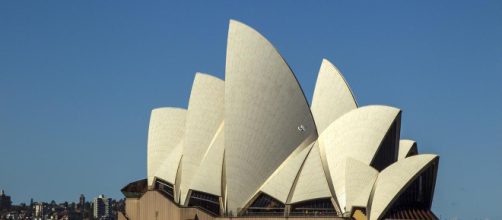Torch-bearing protestors stood by the hundreds before the Sydney Opera House Tuesday night shining their firelight on the building's sails-shaped roofline to wash out a 30-minute projection of an advertisement for a horse race and all the while chanting, “Whose house? Our house.” Their pride is understandable. The 45-year-old performance hall's mark of distinction was those gleaming white peaks seen on clipper ships with the wind at their back and not a commercial in their face. The New South Wales government okayed the ad and the people weren't having it, according to The Guardian.
In plain sight
That demonstration in Australia goes to the issue of turning art into a commodity (the Aussie art being the Opera House architecture) is not unlike the recent million dollar auction of street artist Banksy painting that he caused to self-destruct to denounce monetarizing work he does for free. The Huffington Post got it wrong when it reported the artist's action as, “Banksy Wasn’t Critiquing Capitalism, He Was Taking Part In It.” He made his intentions quite clear in an Instagram when he said that he embedded a shredder in the frame of his painting “in case it was ever put up for auction.”
Up for discussion
Objection to making art a commodity was also the subject of a memorable symposium in London at Saatchi Gallery in 2011.
The question that Saatchi posed centered on art fairs and whether they are merely marketplaces for rich people to speculate for the fun of it, or whether they are for the public to see works they wouldn't otherwise see, thereby serving as a lifeline for artists. The question wasn't resolved, but I took from the debate that art today is more money than art. Folks like the Australian protestors and Banksy long for when the price of art didn't dominate our conversation.
Bogged down
Consider the case of artist Stephen Boggs who painted American currency but with a mark of his own, like signing the dollar bill “J.S. G. Boggs, Secretary of the Treasury,” or “In Fun We Trust.” He never sold any of these paintings, but for 30 years he often paid for goods and services with them.
He called them “Boggs bills.” Examples of his effort are in the collections of the Art Insititute of Chicago, MoMA in New York, and the Smithsonian American Art Museum in D.C. His story was recounted in a New York Times obit when he died last year at 62. And in a 2013 Discovery Channel documentary titled “Secret Life of Money,” Boggs said, “I create images that say things and ask thing...as works of art that ask us about the nature of money.” Providing an unwitting answer to his ask is Andy Warhol's silkscreen of two hundred dollar bills that sold for $43.8 million. Art for art's sake has gone the way of that other old bromide - truth and justice.,


